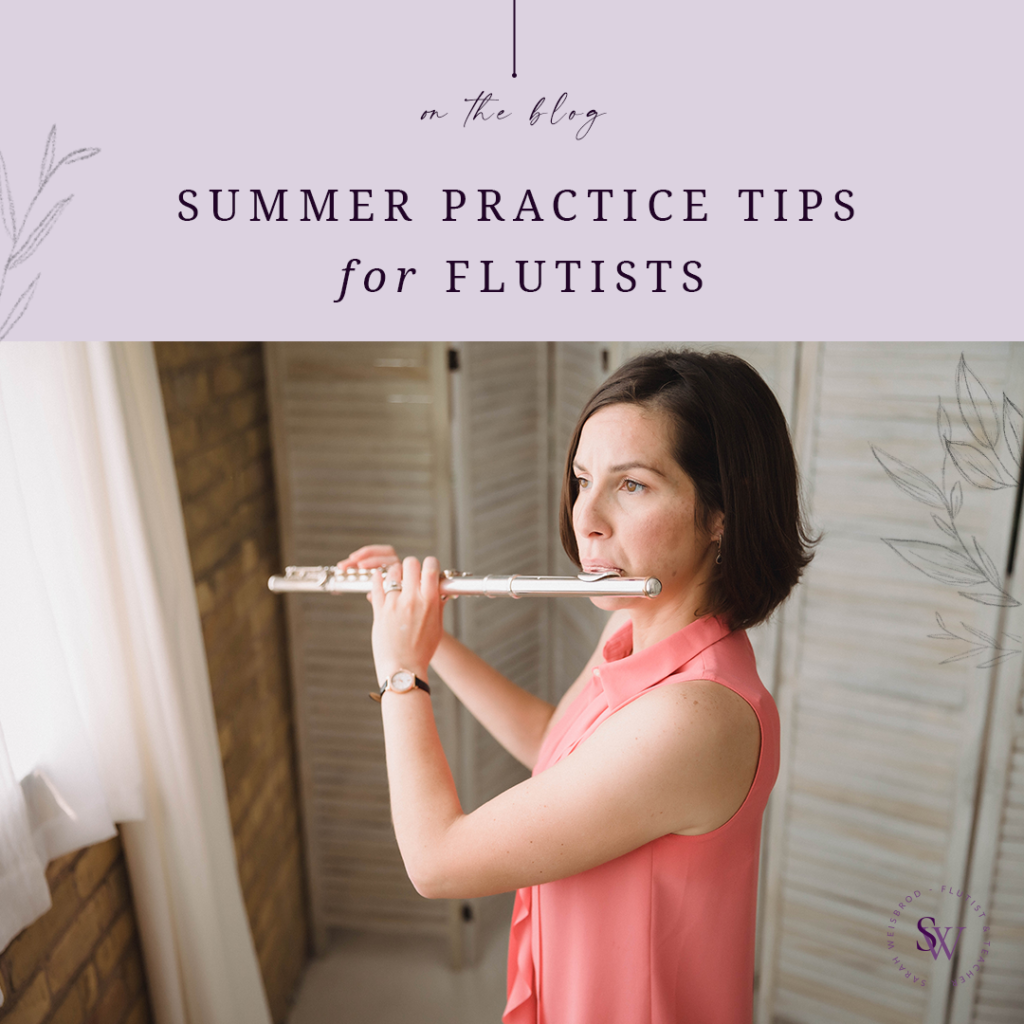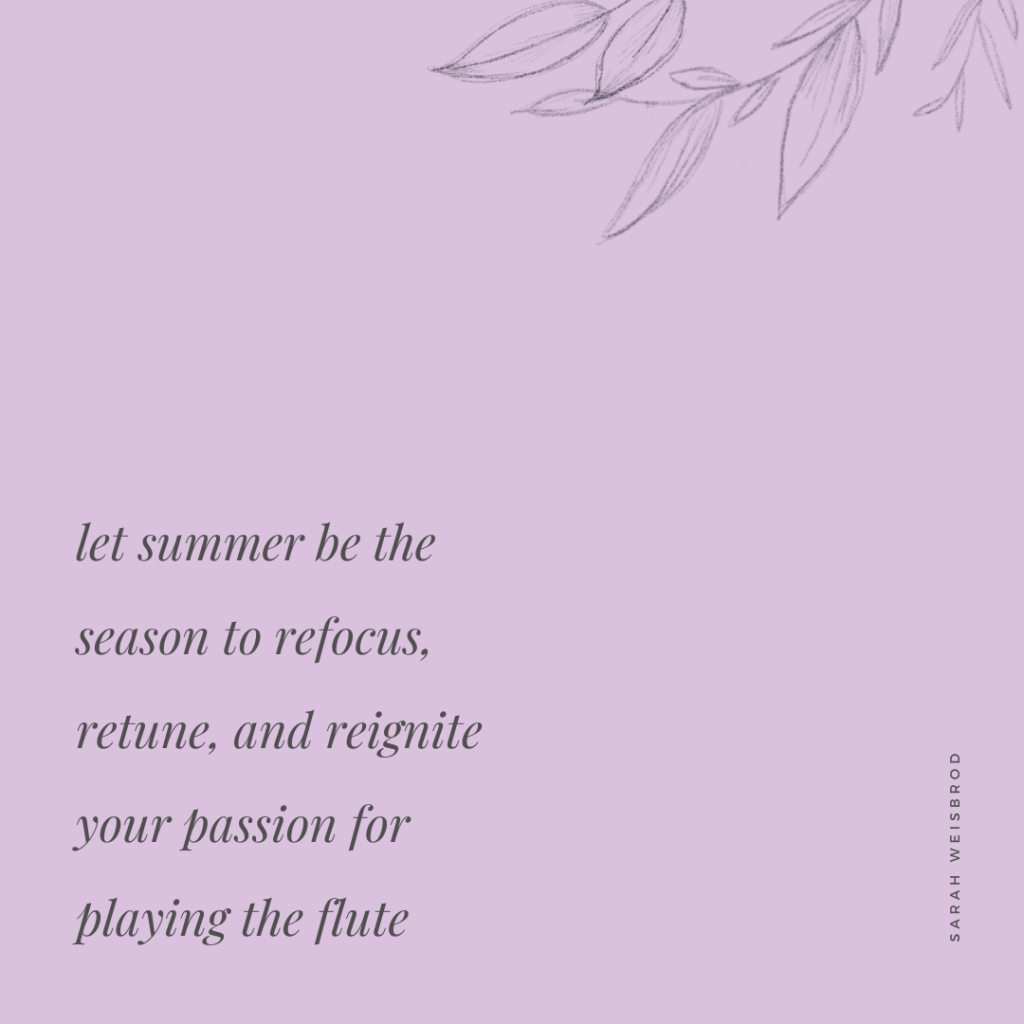Feeling inspired to practice this summer but not sure what you should be doing? I’ve totally been there before. 🙌
When I was a college student, my teacher would send me on my way at the end of each year with my new recital repertoire in hand. It was exciting, but it was also somewhat overwhelming. I thought, “What if I have problems, who will help me?” “Is this all I should work on?”
Obviously, no, you shouldn’t only work on your repertoire in the summer (or in general practice, BTW). Lorna McGhee says that the technique work should come from outside the repertoire. In other words, if you’re working on the Mendelssohn “Scherzo” from A Midsummer Night’s Dream and your double-tonguing isn’t clear, don’t practice double-tonguing on that piece. Practice it using a scale or an etude.
That’s why summer is an excellent time to focus on aspects of your flute playing that get neglected during the school year. I like to think of it as a time to refocus, retune, and reignite my passion for playing the flute. You’ll discover how you can be your own teacher and solve technical issues yourself.
I’m going to share with you what to practice and how so you’ll be ahead once the school year starts back up. Let’s jump in!

What to Practice
I generally like to break up my practice sessions into the following sections:
- Tone Development
- Scales and Technique
- Etudes
- Repertoire
I spend most of my time on tone, scales, and etudes so that by the time I’m ready to practice my repertoire, I’ve already done all the foundational work.
Tone Development
Long Tones
I’m a big proponent of practicing long tones, and they are the first thing I do in my practice sessions. If you find long tones boring, try breaking them up using different books (see below) or try a variation. You can download my long tone variations here.
When you’re practicing long tones, try not to simply go through them as a meaningless exercise. The goal, as Moyse points out in De la sonorité, is to create a homogeneous sound through all registers of the flute. If you’re feeling that your low register is weaker than your upper register, summer is a great time to work on that. If you do even 15 minutes a day of long tones, you’ll see results.
Here are some of my favorite books:
- Marcel Moyse – De la sonorité
- De la sonorité contains the popular descending long tones by semitone (half-step) as well as other exercises that work on sonority including expanding intervals and crescendo/decrescendo exercises.
- Trevor Wye – Practice Book 1: Tone
- Wye’s book builds on the Moyse principles. It begins with harmonics before diving into various long tone exercises in the low register, middle register, and high register. The middle of the book contains flexibility and intonation exercises.
- Philippe Bernold – La Technique d’Embouchure
- A great companion to the Moyse and Wye books, Bernold’s La Technique d’Embouchure focuses on developing even tone throughout all the registers by using arpeggios, vocalises, and other exercises.
Once I’ve completed my long tones, I like to do interval work working in harmonics and broken arpeggios.
Need some long tone exercises, but don’t have the books above? I’ve got you covered. Download my free Expressive Long Tones guide. ⬇️

Harmonics
If you’ve never played harmonics, simply finger a low note (low E or D is a good starter note), and gradually go through the partials still fingering low E. You’ll hear the octave E, a fifth above that B, and then the second octave E (our high E). You can try to go even higher and get a G# to sound.
Harmonics are an excellent way to work on finding the right angle of air for each note. This is especially beneficial in the high register when it’s easy to simply blow harder to get the note to speak.
Arpeggios
Besides the Philippe Bernold book mentioned above, I like to practice broken arpeggios slowly. Moyse has a couple different exercises in his 20 Exercices and Études sur les grand liaisons, les trilles, les points d’orgue, etc. and Études et Exercises Techniques books that are useful in working on gliding through the different registers via large leaps.
Turn Your Own Repertoire Into a Tone Development Study
Do you have a challenging bit in a new piece? Make it a tone development exercise by practicing it slowly and connecting through all the notes in each phrase. I find this particularly useful in fast passages when the connection between notes can get lost.
Practice Melodies
Perhaps one of the most popular etude books for tone development is Moyse’s Tone Development Through Interpretation. Moyse meticulously transcribed popular opera arias into troublesome keys and ranges so that flutists can work on overcoming difficulties on the instrument through melodic studies.
Scales
Mix up your scale practice by switching up articulations, rhythms, and speed. Make your scales sound like beautiful melodies. Incorporate chromatic scales along with thirds, fourths, and fifths.
Taffanel & Gaubert – 17 Grands exercices journaliers de mécanisme
T&G’s 17 Big Daily Exercises is one of my favorite books, and I practice various scales from it every day. If you already practice T&G on a daily basis, then try memorizing various exercises. My personal favorites are #1, #2, #4, #10, and #12.
Moyse – Exercices journaliers
Moyse’s Daily Exercises contains the popular expanded scales in major and minor keys. From the starting note you go up to high B-flat, B, or C, depending on the key and go all the way back down to low C. I like to expand the scales to go all the up to high D and back down to low B, if B-flat isn’t in the key signature.
Reichert – 7 Exercices journaliers pour la flûte
Another well-known daily exercise book, Reichert walks through all the keys in each exercise. The last couple exercises focus on articulation. I like to practice the exercises slowly, especially #5, for accuracy in pitch and connection through the intervals.
Kujala – Vade Mecum
From the Latin meaning “go with me,” Walfrid Kujala’s Vade Mecum covers everything. From scales, broken intervals of 4ths, 5ths, and 6ths, to lesser practiced scales modal, pentatonic, and octatonic scales, there’s something for everyone. Kujala includes exercises based on excerpts of famous works in addition to chromatic scales and sequences.

Etudes
Etudes are an enjoyable way to stay in shape if you don’t have any major repertoire to work on. Revisit old etudes and play through them. Denis Bouriakov likes to play through an etude book a day. Another option is to find a challenging book of etudes and work through them methodically.
In each etude, aim to find the objective. Is it focusing on double-tonguing, trills, appoggiaturas, etc? Regardless of the technical issues to be addressed, always make sure you’re finding the outline of each phrase and playing the etude melodically.
Here are some of my favorite etude books, many of which are available from IMSLP:
- Altès – 26 Selected Studies
- Andersen – 24 Etudes for Flute, Op. 15
- Andersen – 24 Etudes for Flute, Op. 33
- Berbiguier – 18 Exercises for the Flute
- Boehm – 24 Caprices, Op. 37
- Gariboldi – 20 Studies for the Flute, Op. 132
- Jeanjean – Études Modernes Pour Flute [Modern Etudes for the Flute]
- Karg-Elert – 30 Caprices for Solo Flute, Op. 107
- Kohler – Romantic Etudes, Op. 66
- Kohler – 33 Exercises for Flute, Op. 33
Orchestral Excerpts
Use the extra time to work on challenging orchestral excerpts. Intimidated by Firebird? Start working on it now, while you have the time. You don’t want to hear about an audition and have only several weeks to prepare an excerpt.
Find New Repertoire
Summer is a great time to find new repertoire when you’re not under the gun to prepare works for a performance. New rep can be music by older composers or music by new composers. If you’re looking to diversify your repertoire (which you should totally be doing, BTW), check out the NFA’s new extensive repertoire list. You can also join the Flute New Music Consortium. They have a new round of repertoire coming out.
In order for new composers to remain part of the flute canon for decades to come, we must program new works by a wide array of composers (ahem…not just white dudes). It is up to this generation to ensure that works by underrepresented composers become commonplace in flute repertoire.
Revisit Old Repertoire
Have some fun with your practice sessions. Practice some pieces you like, not just pieces your teacher assigned this summer (though you should do that, too). I always enjoy pulling out old pieces and seeing how easy they’ve become.
Take a Break
It’s okay to take a break. Everyone is different. Depending on where you’re at in your playing and age, you might find a break at the end of the school year useful. For example, if you’re a college or high school student wrapping up the school year, you may need a week off of playing the flute to recover from end-of-the-year stress. And, that’s okay. It is absolutely okay to take a break. Breaks can be a great way to reset.
Now you know what to practice and how you can stay motivated this summer. Make sure you organize your practice sessions to get the most out of your time. Check out this blog post on organizing effective practice sessions, which guides you through the practice planning process.
Don’t forget to download your Expressive Long Tones guide. 👇

+ show Comments
- Hide Comments
add a comment